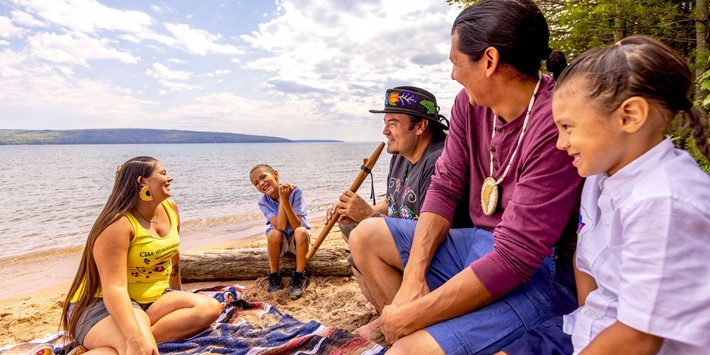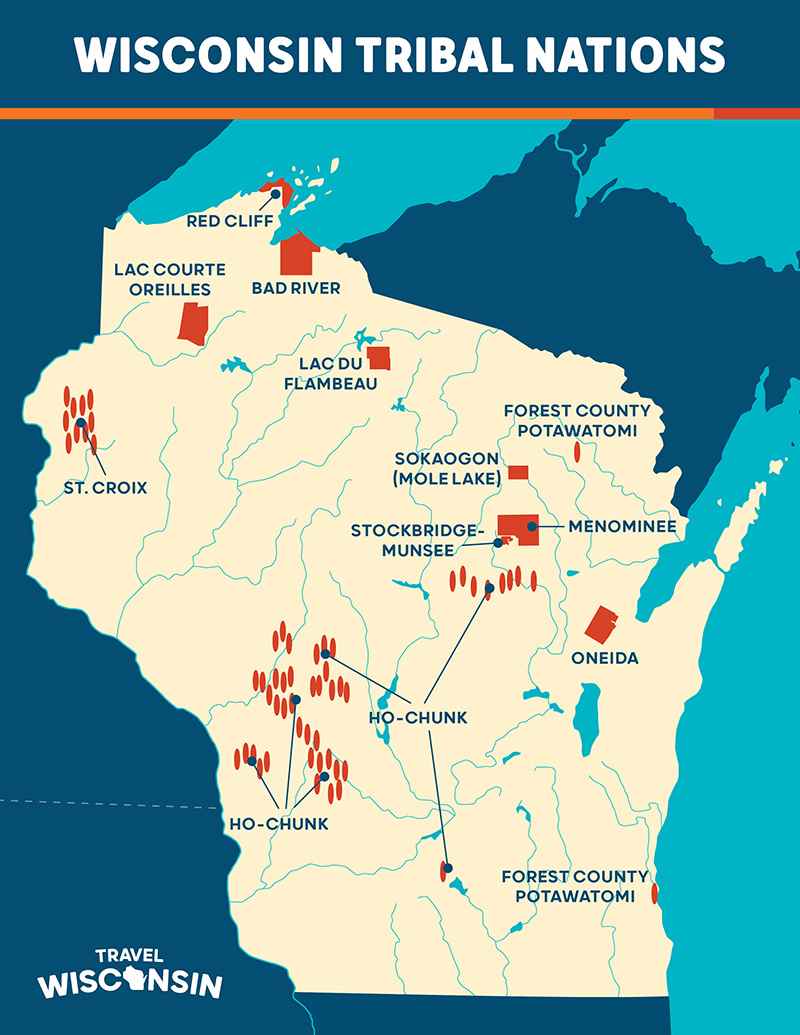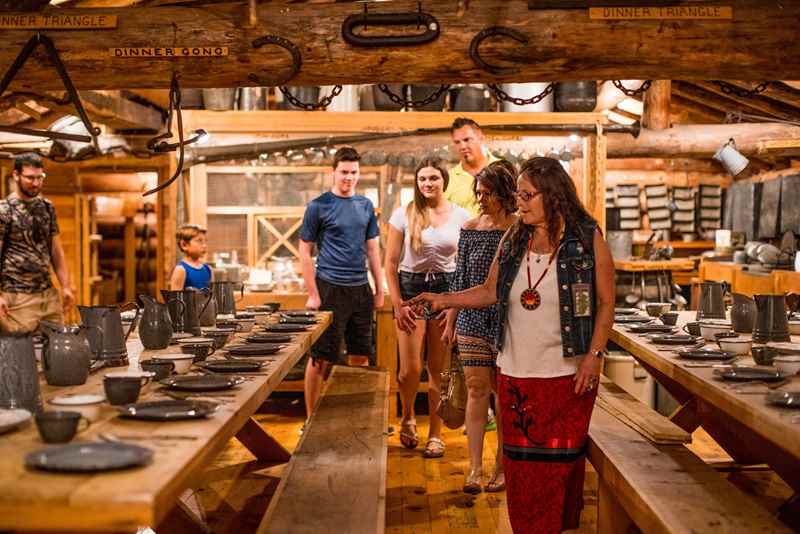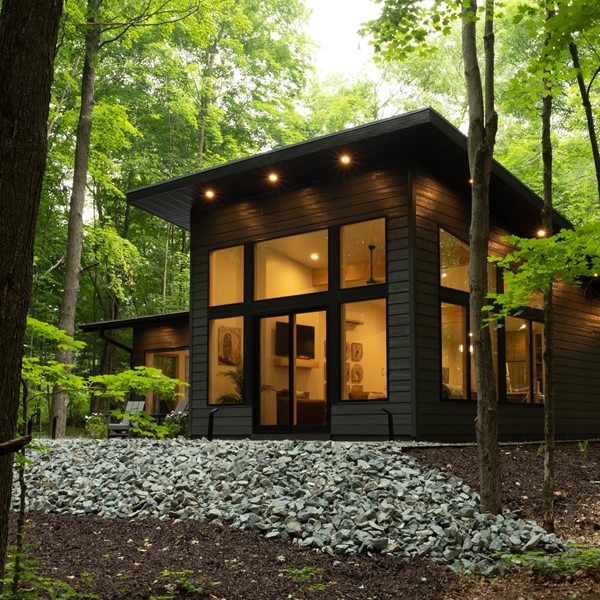
Visit & Learn: Native American Tribes in Wisconsin
Wisconsin has one of the largest concentrations of Native American Tribes east of the Mississippi River, and each has a distinct culture and rich heritage. Read on to learn more about the 11 federally recognized Tribes in Wisconsin and how to experience each Tribe’s culture and support locally-owned businesses.

Bad River Band of Lake Superior Chippewa
The Bad River Band is one of six bands of the Lake Superior Band of Chippewa Indians - also referred to as the Anishinaabe, Chippewa or Ojibwe. This original group was forced to migrate from present-day eastern Canada and the United States to what is now known as Madeline Island in Lake Superior. The reservation was established by the 1854 Treaty of La Pointe with the United States federal government and is situated along the shores of Lake Superior and Chequamegon Bay. The 1854 Treaty also set aside 200 acres on Madeline Island for traditional gathering practices for its members. This island is a longtime capital and cultural or religious center of the Ojibwe people and nations throughout the Great Lakes region.
Located in Ashland County — one of the most northern points of Wisconsin — the Bad River Tribe’s reservation contains almost 500 miles of rivers and streams and over 30,000 acres of wetlands.
Visit the Bad River Lodge, Casino and Convention Center to stay and play with friends and plan to attend the annual Bad River Manoomin Celebration to experience the Tribe’s rich culture.
Ho-Chunk Nation
The Ho-Chunk Nation, or “People of the Big Voice,” is unique in that it is not located on one continuous land base within Wisconsin. Because of a treaty signed under suspicious conditions between the U.S. government and the Tribe in the early 1800s, the Ho-Chunk were forced to cede much of their land. Later on, the Tribe was able to reclaim portions of its land in 14 Wisconsin counties.
Learn more about Ho-Chunk history by attending one of the Tribe’s two major powwows hosted each year on Memorial Day and Labor Day. They feature cultural dancing, drumming competitions and traditional food and crafts, and the public is invited to attend.
Lac Courte Oreilles Band of Lake Superior Chippewa
The Lac Courte Oreilles Tribe is another of six bands of the Lake Superior Band of Chippewa Indians who entered treaties with the United States in the 1800s. There are a number of effigy mounds on the south shore of Lac Courte Oreilles lakes, which provides evidence that the area was home to Mound Builders who may have extended as far back as 500 B.C.
You and your family can stay at The Landing on the Chippewa Flowage to enjoy this beautiful area together. To see historic items from the Tribe including artwork, visit the Lac Courte Oreilles Kinnamon School & Cultural Center in Hayward.
Lac du Flambeau Band of Lake Superior Chippewa
This Tribe acquired the name Lac du Flambeau from its gathering practice of harvesting fish at night by torchlight. The name Lac du Flambeau, or Lake of the Torches, refers to this practice and was given to the Band by the French traders and trappers who visited the area.
Explore a large collection of Lac Du Flambeau history at The George W. Brown, Jr. Ojibwe Museum & Cultural Center, where rare artifacts, birch bark canoes, traditional clothing and more are on display.
Menominee Tribe of Wisconsin

The Menominee Tribe's history is unique in part because its origin or creation begins at the mouth of the Menominee River, just 60 miles east of the present Menominee Reservation. The Tribe has resided in parts of modern-day Wisconsin, Michigan and Illinois for over 10,000 years.
Dive into more history of the Menominee Tribe and the surrounding area at the Menominee Logging Museum, the largest and most complete logging museum in the United States.
Oneida Nation
The Oneida, along with the Mohawk, Seneca, Cayuga and Onondaga comprised the original Five Nations of the Iroquois Confederacy (also known as the Haudenosaunee) dating back to the 1500s. In the 1820s, the Oneida were forced to relocate from the state of New York to what would become Wisconsin.
Stop in the Oneida Nation Museum near Green Bay to see original Iroquois artwork and historical artifacts and take home treasures from the gift shop. You can also visit a reconstruction of a traditional Oneida longhouse, made of bark and occupied by several families of the same clan, on the Oneida Reservation.
Forest County Potawatomi
The Potawatomi make up a part of the Anishinabe confederacy, known as the "Keepers of the Fire," and the fire symbol is used prominently in their Tribe still today. Other Potawatomi bands are located in Kansas, Michigan, Oklahoma and Canada.
Potawatomi State Park includes two beautiful miles of Lake Michigan shoreline in Door County. In Crandon, visit the impressive Forest County Potawatomi Museum & Cultural Center which contains a large collection of historical and contemporary photographs, audio and video files and treaties as well as an interactive language exhibit and a library focused exclusively on Native Studies.
Red Cliff Band of Lake Superior Chippewa

The Red Cliff Band is known for its red-colored cliffs along the shores of Gitchigami, or Lake Superior.
Take a trip to Frog Bay Tribal National Park, the first park of its kind in the nation, which offers visitors stunning views of Lake Superior and the Apostle Islands. Visit in September for the annual Red Cliff Cultural Days that guarantees family fun with carnival games, tasty food and cultural information booths.
St. Croix Chippewa
The St. Croix Chippewa Indians are a historical Band of Ojibwe located along the St. Croix River, which forms the boundary between Wisconsin and Minnesota. With a wealth of lakes and forest on their reservation, the St. Croix are able to practice the traditional harvesting of wild rice, maple syrup, berries, fish and deer, and share the bounty with surrounding communities.
Visit Forts Folle Avoine Historical Park in Danbury – a re-creation of a Woodland Indian village and fur trading post that was on this site between 1802 and 1805. Start at the 5,000-square-foot visitor center for some background about the Nation’s centuries of history. Then, experience that history up close as you listen to guides dressed in the period’s fashion barter over furs as they did 200 years ago.
Sokaogon Chippewa (Mole Lake)
The word Sokaogon means “Post in the Lake” people, because of the spiritual significance of a post, possibly the remains of a petrified tree, that stood in nearby Post Lake. The Sokaogon Chippewa Community is also known as the “Lost Tribe” because the legal title to the 12-mile square reservation from the treaty of 1854 was lost in a shipwreck on Lake Superior.
Today, the Sokaogon Chippewa Community (also known as the Mole Lake Band of Lake Superior Chippewa) continues to harvest wild rice and spearfish in traditional ways. Utilizing state-of-the-art technology, their nation continues to protect the environmental resources for future generations.
Attend the Honor the Earth Homecoming Celebration and Powwow held each summer to learn more about the heritage and culture of both Sokaogon and other bands of Ojibwe Tribes.
Stockbridge-Munsee Community Band of Mohican Indians
Known as the “People of the Waters that are Never Still,” the Stockbridge-Munsee community was uprooted many times before moving to their present land in Wisconsin. They were forced to leave their Mohican homeland, on the banks of what is now the Hudson River in New York, in the 1700s.
Explore an archive of Mohican artifacts at the Arvid E. Miller Library & Museum in Bowler. Exhibits include rare books, microfilm of the Green Bay Indian Agency and maps dating from the early 1600s. Listen to Tribal elders tell stories of their lives through videos at the museum for a meaningful glimpse into the Stockbridge-Munsee Community Band of Mohican Indians.
Learn more about Wisconsin’s Native American culture and the unique histories of each tribe at NATOW.org.










